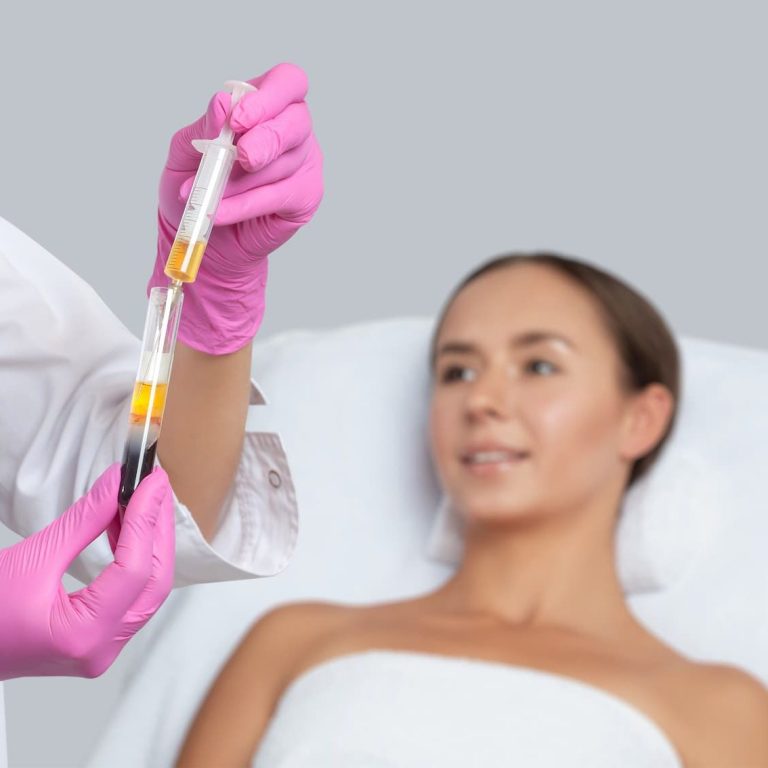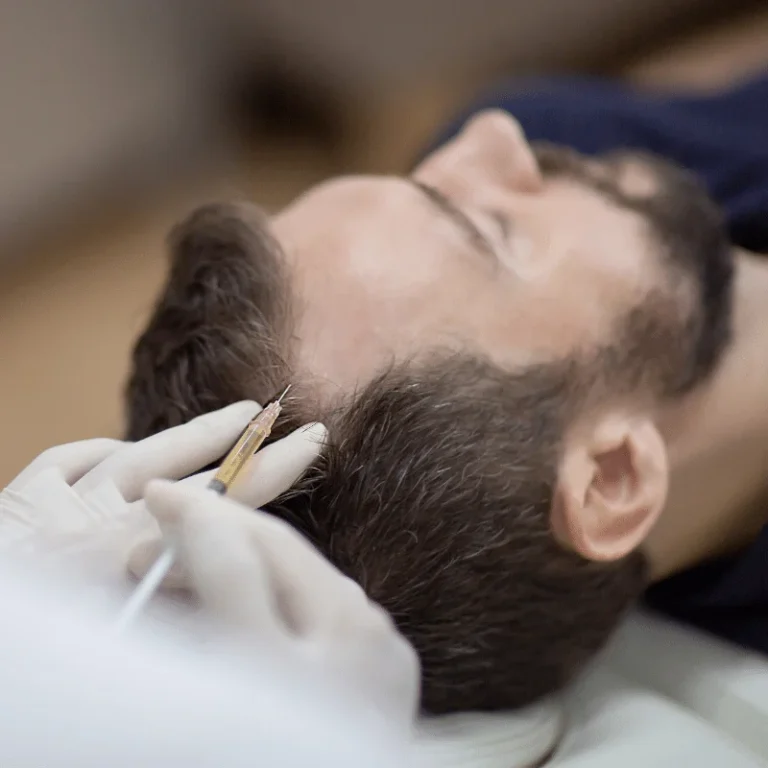Platelet-Rich Plasma (PRP) Treatment
What is PRP?
Platelet-Rich Plasma (PRP) therapy is a revolutionary treatment that utilizes the body's natural healing abilities to rejuvenate the skin, stimulate hair growth, and promote tissue regeneration. PRP is derived from a small sample of your own blood, which is processed to concentrate the platelets and growth factors. These components play a vital role in repairing damaged tissues, boosting collagen production, and enhancing overall skin health.
PRP treatments are widely used in aesthetic medicine due to their ability to deliver natural, long-lasting results with minimal downtime. Since PRP is extracted from your own blood, the risk of allergic reactions or adverse effects is significantly reduced, making it a safe and effective treatment for a variety of concerns.

PRP (Platelet-Rich Plasma) facial,
A PRP (Platelet-Rich Plasma) facial, is a skin rejuvenation treatment that uses your own blood's healing properties to promote collagen production, improve skin texture, and reduce signs of aging.
How It Works:
Blood Draw – A small amount of your blood is taken, just like in a routine blood test.
Centrifuge Process – The blood is spun in a centrifuge to separate the platelet-rich plasma (PRP) from red blood cells.
Microneedling or Injection – The PRP is either applied topically after microneedling (creating tiny channels in the skin) or injected directly into targeted areas.
Benefits of PRP Facial:
Boosts collagen and elastin production for firmer, younger-looking skin
Reduces fine lines, wrinkles, and acne scars
Improves skin tone and texture
Helps with hyperpigmentation and dark circles under the eyes
Accelerates skin healing and reduces inflammation
Uses your body’s natural healing properties, so there’s minimal risk of rejection.
Other Areas Include;
PRP for the Neck
Targets loose, crepey skin and fine lines.
Stimulates collagen production to firm and tighten.
Improves skin texture and reduces wrinkles.
Often combined with microneedling for deeper penetration.
PRP for the Chest (Décolletage)
Helps with sun damage, pigmentation, and wrinkles.
Boosts hydration and elasticity.
Reduces crepey skin and fine lines.
Can be combined with laser or microneedling.
PRP for the Hands
Improves volume loss and thinning skin.
Treats wrinkles, sunspots, and texture issues.
Restores youthful appearance.
Often paired with dermal fillers for added plumpness.
Who Can Benefit?
PRP facials are ideal for people who want natural anti-aging benefits or those looking to improve acne scars, dull skin, fine lines, and sun damage. It’s safe for most skin types but may not be recommended for those with blood disorders or certain medical conditions.
Downtime & Aftercare
Mild redness and swelling for 24–48 hours
Avoid makeup, excessive sun exposure, and harsh skincare products for a few days
Full results appear within a few weeks and improve over time with multiple sessions usually required, thereafter maintenance appointments every few months fr optimal results.

PRP Hair Loss
PRP therapy is a highly effective, non-surgical solution for individuals experiencing hair thinning or hair loss. By injecting PRP directly into the scalp, the treatment stimulates dormant hair follicles, encourages new hair growth, and strengthens existing hair. This treatment is particularly beneficial for those with androgenetic alopecia (male and female pattern baldness) and other forms of hair thinning.
How PRP Works for Hair Restoration
Blood Collection – A small amount of blood is drawn from your arm.
Processing – The blood is placed in a centrifuge to separate the platelet-rich plasma from other components.
Injection into Scalp – The concentrated PRP is injected into areas of thinning hair to stimulate hair follicles.
Natural Growth Stimulation – Growth factors in PRP work to repair and reactivate weak follicles, promoting thicker, stronger hair growth.
Benefits of PRP for Hair Loss
Stimulates natural hair regrowth
Strengthens and thickens existing hair
Reduces hair shedding and breakage
Minimally invasive with little to no downtime
Uses your own natural plasma, reducing the risk of adverse reactions
Ideal Candidates for PRP Hair Restoration
PRP therapy is suitable for individuals experiencing mild to moderate hair thinning. It is most effective for those in the early stages of hair loss, where hair follicles are still present but weakened. It may not be as effective for individuals with complete baldness or severe hair loss.
How Many Sessions Are Needed?
For optimal results, a series of 3-4 treatments spaced 4-6 weeks apart is typically recommended. Maintenance treatments every 6-12 months help sustain hair growth and prevent further thinning.
What to Expect After PRP Hair Treatment
Minimal Downtime – Some redness and mild swelling at the injection sites, which usually subside within a few hours.
Gradual Improvements – Hair growth occurs gradually over several months, with noticeable results typically seen within 3-6 months.
Combination Treatments – PRP can be combined with microneedling or hair growth serums to enhance effectiveness.
Is PRP Right for You?
PRP therapy is suitable for most individuals looking to improve their skin, hair, or overall tissue health naturally. However, it may not be recommended for individuals with certain medical conditions, blood disorders, or active infections. A consultation is necessary to determine if PRP is the right option for you.
PRP is a game-changer in aesthetic medicine, offering a natural, effective solution to many skin and hair concerns. Whether you're looking to refresh your complexion, restore thinning hair, or enhance your skin’s natural healing process, PRP therapy can help you achieve your aesthetic goals with long-lasting results.
Disclaimer: PRP treatments are a medical aesthetic procedure and results may vary between individuals. While PRP therapy is generally safe and well-tolerated, there is no guarantee of specific results. Some individuals may require multiple sessions for optimal benefits. PRP is not suitable for individuals with certain medical conditions, including blood disorders, active infections, or those taking specific medications. A consultation is required to determine suitability. Side effects such as mild swelling, redness, or bruising may occur but typically resolve quickly. Always follow post-treatment care instructions provided by your practitioner.
We need your consent to load the translations
We use a third-party service to translate the website content that may collect data about your activity. Please review the details in the privacy policy and accept the service to view the translations.